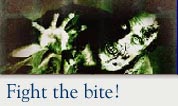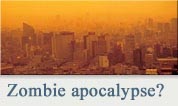I've seen all of George A. Romero's zombie movies, starting with Night of the Living Dead (NOTLD), and found them a little boring. To be fair, this is because everyone's been ripping off Night of the Living Dead since he created NOTLD, so what appears to be tired zombie fare to my jaded eyes is actually what Romero started.
Zombies in Night of the Living Dead are slow, shambling, recently dead people. There are no running zombies here. They can spread their contagion with a bite. The only way to stop them is by blowing their brains out (or stabbing them in the brain, or setting their brains on fire, you get the idea). This traditional zombie trope has been done to death (pun intended), such that it's become a bit difficult to take slow moving zombies seriously.
Zombies were originally conceived as allegories first, horror monsters second. The strength of Night of the Living Dead wasn't just the terror of cannibalistic strangers assaulting a home; it was the threat of the unwashed masses overwhelming the middle class. The zombies in Romero's movies are slow, but they are relentless, and their numbers are legion. Never mind that you can outrun them...eventually, they will catch up to you. Who's worse: the zombies outside or the people who will do anything to survive on the inside? We know Romero's answer.
This class warfare was further explored in Dawn of the Dead, where we had the comedic "shopping zombies." The film established that zombies struggle to recapture their old life, shambling aimlessly about in shopping malls...sort of like what they did when they were alive anyway. Dawn of the Dead posited: Are zombies any different from uninvolved and unaware living citizens? We know Romero's answer.
By Day of the Dead, we had the other side of the coin. The previous films followed the travails of pockets of civilization and their struggle for survival. In Day of the Dead, humanity's last hope is sequestered in a military installation. There, scientists struggle to discover a cure, wage a philosophical (and sometimes physical) battle. We're also introduced to Bub, a zombie who can learn. Can the lower classes become better through education? We know Romero's answer.
Land of the Dead is the fourth movie in the series, and this time there's far less claustrophobia. Whereas the first three movies centered on human protagonists holing up in a farmhouse, mall, or military base, the humans in Land of the Dead live in a city. And this city has the full range of human triumph and misery, from its slums to a glittering tower known as Fiddler's Green. Lorded over by Kaufman (Dennis Hopper), it's a microcosm of society: white socialites in suits dine at the top of the tower while the poor mingle in all manner of vices, many of them supported by an easy supply of non-humans: the zombies.
But even the most powerful city has to be powered somehow, and ruthless scavengers (who drive an armored tank known as Dead Reckoning) stock Fiddler's Green. This miracle of modern technology has a front-mounted gatling gun, missile launchers, nightvision, and armor plating. It's just what you'd want if you were fighting zombies. Riley (Simon Baker...wait, not that Simon Baker) lead his team, along with his cheeky second in command, Cholo (John Leguizamo). Charlie (Robert Joy), who is mentally disabled and disfigured, follows Riley around like a puppy. He also happens to be a crack shot. There's also an ex-hooker named Slack (Asia Argento) who provides an audience point of view to the whole situation, but seems primarily to be there as a thank you to her infamous horror movie producer father, Dario Argento.
The opening scene, wherein Riley and Cholo demonstrate different interpretations of the term "critical supplies," sums up the movie's ethos very quickly. Cholo thinks booze and smokes are critical because they might gain him some influence with Kaufman, maybe even letting the mercenary move into Fiddler's Green. Conversely, Riley wants to get antibiotics for the sick child of his friend. Both men believe it will be their last mission amongst the "stenchers," the phrase the humans use for the zombies.
But there's more to the zombies than meets the eye. A former gas station attendant turned zombie, Big Daddy (Eugene Clark), is a "zombie lord" of sorts. He is self-aware and capable of learning, just like Bub. He remembers parts of his old life and, more importantly, sympathizes with his zombie brethren. When they are wounded, he is outraged. Most frightening of all, Big Daddy can teach the other zombies what he knows. It doesn't take long before he leads a zombie rebellion-straight towards Fiddler's Green.
When Cholo discovers that his boss will never give him a place in Fiddler's Green, no matter how many troublemakers he murders (along with the zombies), things turn ugly. Cholo steals Dead Reckoning and drives off with the intent of holding the city hostage until he gets enough money to start his own city. Ironically, Riley has the same plans, but discovers his car is stolen...because Kaufman wants him to stay. Kaufman then promises Riley his freedom if he steals Dead Reckoning back before Cholo blows up the whole city.
Land of the Dead is surprisingly engaging; it's probably the first pro-zombie movie ever, casting the undead as sympathetic, pathetic, and clearly underclass: they are butchers, musicians, and yes, gas station attendants. And as the zombies become more self aware, they lust for what the humans already have...more than just flesh, but their homes. At first, fireworks awe the stenchers. But eventually, even that is not enough to preoccupy them.
Romero knows his zombies well and films them in all their alternately gory, comedic and yes sometimes-beautiful glory. We watch zombies from a God's-eye view, when they look only like everyday citizens, wandering about. We see zombie and anguished citizens alike in a writhing pile of corpses and teeth. Everywhere, Romero never lets us forgot that if you squint your eyes just enough, a zombie looks just like a person. And if you can confuse the two, maybe things aren't so black and white as life and death, "living" and "stencher."
The parallels to modern day are a bit more subtle than say, Revenge of the Sith. But they're still there. Kaufman "refuses to negotiate with terrorists." The zombie life seems almost idyllic before the tank-like Dead Reckoning invades from Fiddler's Green, blowing the zombie-citizens to smithereens. It becomes rapidly apparent that Romero wants us to see the zombies not just as undead foils or evil monsters, but as people. And if they are capable of thought, then do the supposedly civilized humans have the right to shoot them in the head and take their resources?
We know Romero's answer.
Land of the Dead is a traditional zombie film with a lot to say. Kids accustomed to the 2004 Dawn of the Dead-speed of horror will undoubtedly be disappointed. But for adults who want a bit more from zombies than just dead people, Land of the Dead is lively indeed. StatCounter - Free Web Tracker and Counter
Labels: Zombie Reviews





0 Comments:
Post a Comment
<< Home